The Chia Network aspires to be a beacon of innovation, often challenging the conventional paradigms of blockchain and digital currencies. At the heart of this revolution lies the concept of Decentralized Autonomous Organizations (DAOs), a crucial organizational structure for democratizing decision-making and governance in the digital age. Here, we delve into a pivotal discussion hosted by the Chia Network, centered around CHIP-24, the Chia Improvement Proposal for DAO1, a proposal that could redefine the future of decentralized governance on the Chia blockchain.
Table of Contents
- Background Info: CHIPs
- Unpacking the DAO1 Standard on Chia – Video Summary
- Technical Deep Dive
- Implications for Chia and the Blockchain Community
- Conclusion
- FAQ
Background Info: Chia Improvement Proposals (CHIPs)
Chia Improvement Proposals, or CHIPs, serve as the lifeblood of innovation within the Chia ecosystem. These proposals, crafted by members of the community, aim to introduce new standards, features, or modifications to the Chia blockchain, ensuring its continuous evolution and adaptation to the needs of its users. The introduction of DAOs into this ecosystem marks a significant milestone, offering a glimpse into a future where organizations are governed not by a central authority, but by a collective of decentralized members.
The concept of DAOs is not new to the blockchain world, yet its implementation within the unique framework of the Chia blockchain presents both challenges and opportunities. DAOs operate on the principle of collective decision-making, where members, often anonymous or pseudonymous, vote on proposals affecting the organization’s direction and allocation of resources. This democratic approach to governance stands in stark contrast to traditional organizational structures, promising a more transparent, equitable, and efficient way of managing collective endeavours.
The proposed DAO1 standard on Chia seeks to establish a foundational architecture for DAOs on the blockchain, outlining the mechanisms for membership, voting, and the execution of decisions. This initiative not only highlights Chia’s commitment to fostering innovation and community participation but also sets the stage for a broader discussion on the role of DAOs in the future of decentralized finance and governance.
As we explore the intricacies of the CHIP-24 discussion, we invite you to join us on a journey through the technical, social, and economic implications of DAOs on the Chia Network. This conversation is not just about a single proposal; it’s about envisioning a new paradigm for collaboration and governance in the digital era.
Unpacking the DAO1 Standard on Chia – Video Summary
In a groundbreaking discussion led by the Chia Network, the blueprint for the future of decentralized governance through the proposed DAO1 standard is meticulously laid out. This conversation, a confluence of minds from the Chia team, not only sheds light on the architectural design of DAO1 but also explores the transformative role of DAOs in enabling a new era of decentralized decision-making. Let’s dive into the core elements of this discussion, unraveling the intricacies of DAO1 and its potential to reshape the landscape of the Chia blockchain.
Architectural Design of DAO1
At the forefront of this dialogue is the design architecture of DAO1, a meticulously crafted blueprint that aims to integrate the principles of decentralized governance into the Chia blockchain. The proposed standard introduces a robust framework for DAOs, outlining a system where decisions are not centralized but distributed across a network of participants. This architecture is not just about creating a new feature within Chia; it’s about laying the groundwork for a future where the community holds the reins of governance, steering the direction of the blockchain with collective wisdom and insight.
The Role of DAOs in Decentralized Decision-Making
Central to the discussion is the transformative role of DAOs in fostering decentralized decision-making. DAOs, as envisioned in the DAO1 standard, serve as the embodiment of democracy in the digital age, enabling a level of participation and transparency seldom seen in traditional organizational structures. Through DAOs, members of the Chia community can propose, vote on, and implement changes directly, ensuring that the evolution of the blockchain reflects the collective will of its users. This shift towards decentralized governance represents a significant departure from the status quo, promising a more equitable and participatory future for the Chia ecosystem.
Technical Details and the Role of “DAO CATs”
Delving deeper into the technical fabric of DAO1, the discussion highlights the innovative use of “DAO CATs” — a novel mechanism for membership and voting within DAOs on the Chia blockchain. These “DAO CATs,” or Chia Asset Tokens, serve as the cornerstone of participation, granting members the right to vote on proposals and influence the direction of the DAO. This mechanism not only simplifies the process of voting but also ensures that governance is accessible and secure, leveraging the inherent advantages of the blockchain to facilitate a fair and transparent decision-making process.
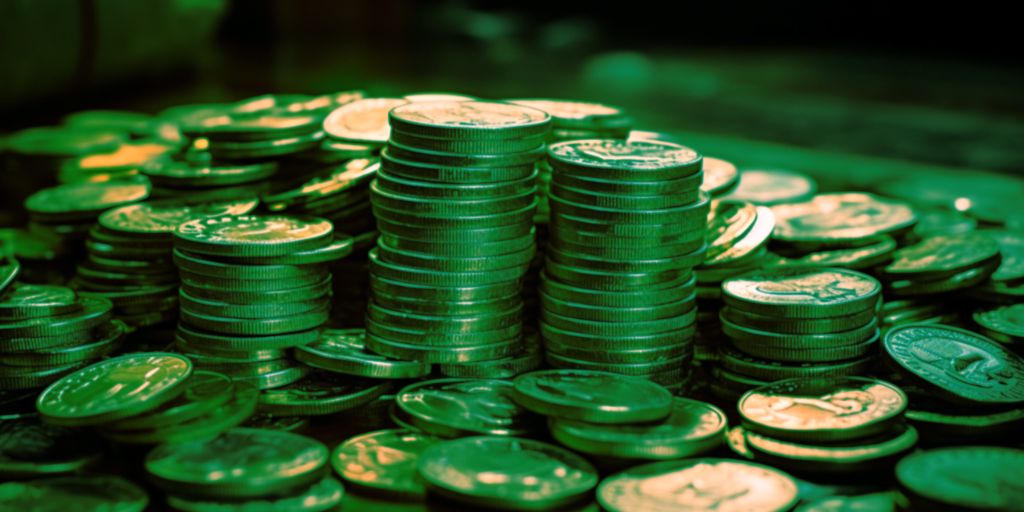
Challenges and Considerations
However, the path to integrating DAOs within Chia’s unique coin set model is fraught with challenges and considerations. The discussion candidly addresses the technical hurdles and design considerations that the team has navigated in developing the DAO1 standard. From ensuring the security of the treasury system to designing a resilient proposal and voting mechanism that withstands potential attacks, the Chia team has meticulously worked to address these challenges. The conversation sheds light on the delicate balance between innovation and security, highlighting the team’s commitment to creating a DAO framework that is both robust and flexible, capable of supporting the dynamic needs of the Chia community.
Section Summary
The discussion on the proposed DAO1 standard on Chia is more than a technical overview; it’s a glimpse into a future where decentralized governance becomes the norm, not the exception. Through the architectural design of DAO1, the role of DAOs in decision-making, the innovative use of “DAO CATs,” and the careful consideration of challenges, the Chia Network is paving the way for a new era of blockchain governance. As we stand on the brink of this new frontier, the conversation invites us to imagine a world where the power of governance is distributed, transparent, and firmly in the hands of the community.
Technical Deep Dive: The DAO1 Standard Unveiled
In the intricate world of blockchain technology, the Chia Network’s discussion on the DAO1 standard emerges as a beacon of innovation, offering a deep dive into the technical underpinnings that could revolutionize decentralized governance. This section peels back the layers of the DAO1 architecture, exploring the sophisticated engineering that makes this vision a tangible reality. Let’s embark on a journey through the technical landscape of DAO1, where complexity meets clarity in the quest for decentralized decision-making.
DAO1 Framework; Engineering the Future
At the heart of the DAO1 standard lies a framework designed to seamlessly integrate decentralized autonomous organizations into the Chia blockchain. This framework is not just a set of rules but a blueprint for a new form of governance, where every line of code and every protocol is meticulously crafted to support a decentralized future. The technical architecture of DAO1 is a testament to the ingenuity of the Chia team, who have navigated the complexities of blockchain technology to create a system that is both robust and adaptable.
The Treasury System: A Cornerstone of DAO1
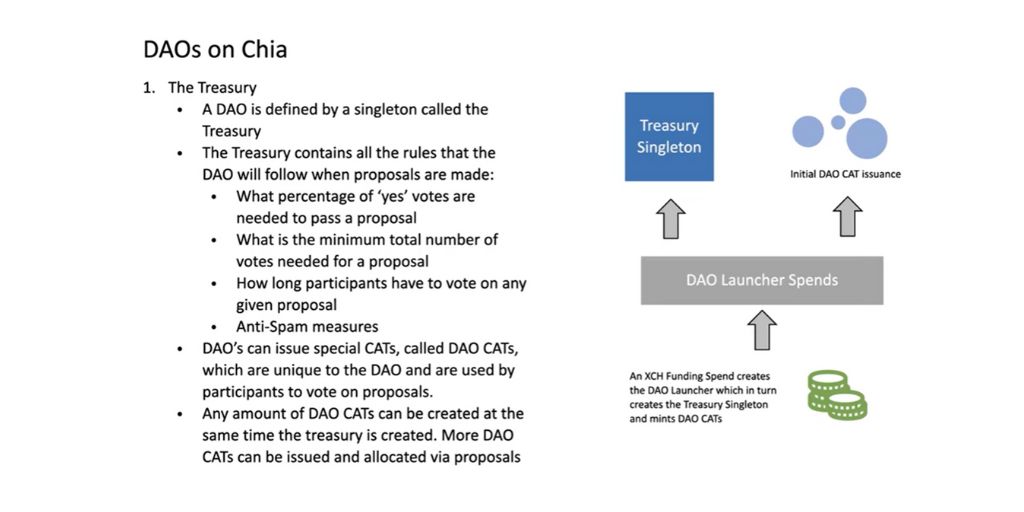
Central to the DAO1 architecture is the treasury system, a novel approach to managing the collective resources of a DAO. This system is designed to hold and allocate funds in a manner that is secure, transparent, and aligned with the collective decisions of the DAO members. The treasury system represents a fundamental shift from traditional financial management, leveraging the blockchain’s inherent security and transparency to ensure that every transaction and allocation reflects the will of the community.
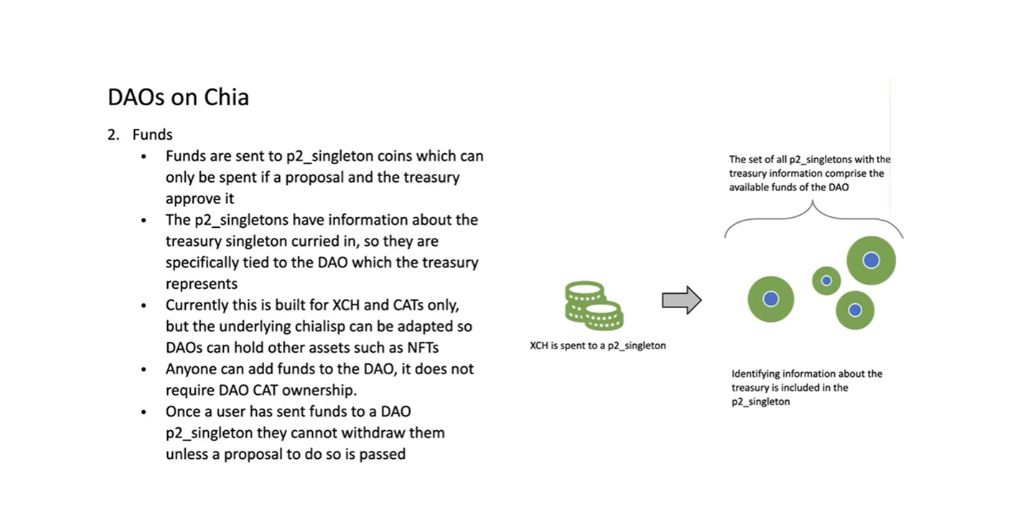
Proposals and Voting: The Heartbeat of Decentralized Governance
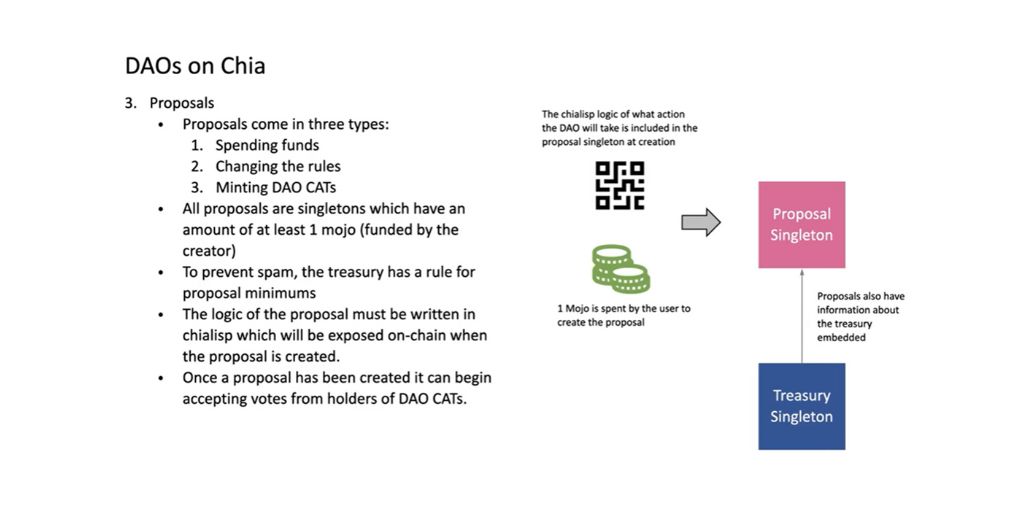
The DAO1 standard introduces a sophisticated mechanism for proposals and voting, serving as the heartbeat of decentralized governance. This mechanism allows members to propose changes, initiatives, or allocations, which are then subject to a democratic voting process. The use of “DAO CATs” for voting not only simplifies this process but also enhances its security, ensuring that every vote is verifiable and tamper-proof. This approach to proposals and voting underscores the DAO1 standard’s commitment to creating a governance model that is participatory, transparent, and resilient.
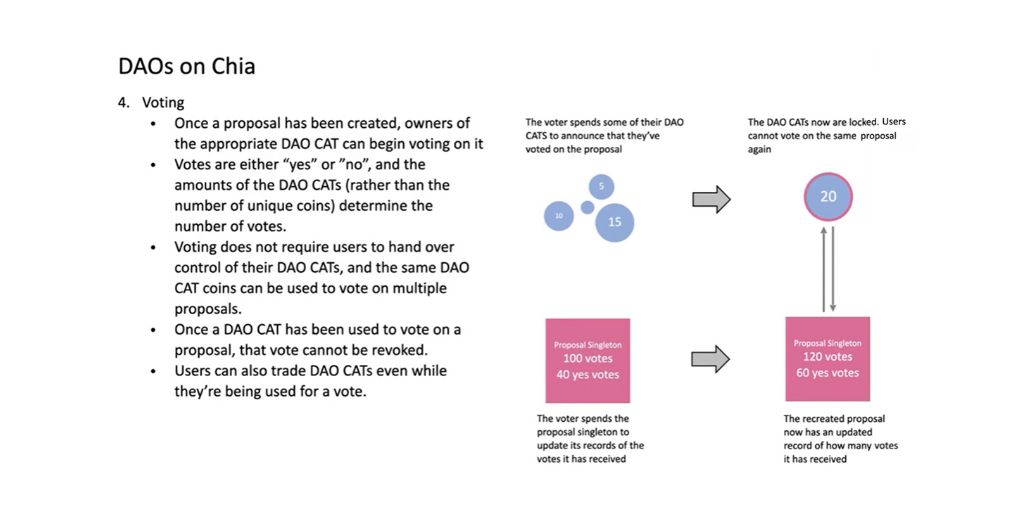
Navigating Challenges: Security and Scalability
The journey to integrate DAOs within Chia’s coin set model has been marked by significant challenges, particularly in terms of security and scalability. The Chia team has approached these challenges with a blend of technical acumen and creative problem-solving, developing solutions that safeguard the DAO1 framework against potential threats while ensuring its scalability. From designing a robust treasury system to implementing secure voting mechanisms, the team has addressed the technical hurdles with precision and foresight, laying the groundwork for a DAO framework that is both secure and capable of evolving with the needs of the community.
Section Summary
The technical deep dive into the DAO1 standard reveals a world of possibilities for decentralized governance on the Chia blockchain. Through the innovative engineering of the DAO1 framework, the Chia Network is not just proposing a new standard; it is reimagining the future of collective decision-making. As we explore the technical intricacies of DAO1, we are reminded of the power of technology to transform society, offering a glimpse into a future where governance is not just decentralized but truly democratic.
Implications for Chia and the Blockchain Community: A New Governance Paradigm
As we stand on the precipice of a new era in blockchain technology, the introduction of the DAO1 standard by the Chia Network heralds a transformative shift not just for Chia but for the broader blockchain community. This pivotal moment invites us to contemplate the far-reaching implications of decentralized autonomous organizations and their potential to redefine the principles of governance in the digital age. Let’s explore the broader impact of DAO1, envisioning a future where the ethos of decentralization permeates every facet of blockchain innovation.
A Leap Forward for Chia: Democratizing Governance
For the Chia Network, the DAO1 standard represents a leap forward in its mission to create a more secure, efficient, and user-centric blockchain. By embracing decentralized governance, Chia is not merely introducing a new feature; it is fundamentally rethinking how decisions are made within its ecosystem. This shift towards DAOs signifies a commitment to transparency, inclusivity, and community empowerment, setting a new benchmark for blockchain governance. As Chia pioneers this approach, it paves the way for a future where the community’s voice is not just heard but is instrumental in shaping the blockchain’s evolution.
Catalyzing Change Across the Blockchain Sphere
The implications of DAO1 extend far beyond the confines of the Chia Network, serving as a catalyst for change across the entire blockchain sphere. By demonstrating the feasibility and benefits of decentralized governance, Chia sets a precedent that could inspire other blockchain projects to explore similar paths. This ripple effect has the potential to transform the landscape of blockchain technology, fostering a more democratic, equitable, and resilient ecosystem. As more projects adopt DAO-based governance models, we may witness a collective shift towards a more decentralized and participatory approach to decision-making.
Challenges and Opportunities: Navigating the DAO Landscape

The journey towards decentralized governance is not without its challenges. The implementation of DAOs raises complex questions about security, scalability, and legal compliance, requiring innovative solutions and continuous refinement. However, these challenges also present opportunities for growth and learning within the Chia community and the broader blockchain ecosystem. By addressing these hurdles head-on, Chia and other blockchain projects can strengthen their foundations, enhance their resilience, and build trust with their users. The exploration of DAOs thus becomes a journey of collective problem-solving, driving progress and innovation in the blockchain space.
Envisioning a Decentralized Future
The DAO1 standard is more than a technical achievement; it is a vision for a decentralized future, where governance is not centralized in the hands of a few but distributed across a network of engaged and empowered participants. This vision challenges us to reimagine the possibilities of blockchain technology, inspiring a future where decentralized governance is the norm rather than the exception. As we reflect on the implications of DAO1 for Chia and the blockchain community, we are reminded of the transformative power of technology to create more open, transparent, and democratic systems of governance.
Section Summary
The introduction of the DAO1 standard by the Chia Network marks a significant milestone in the evolution of blockchain technology, with profound implications for Chia and the broader blockchain community. As we venture into this new era of decentralized governance, we are not just witnessing a technical innovation but a philosophical shift towards a more democratic and participatory model of decision-making. The journey ahead is filled with both challenges and opportunities, but the promise of a decentralized future offers a compelling vision that drives us forward, together.
Conclusion: Charting the Course Towards Decentralized Governance
As we conclude our exploration of the DAO1 standard and its implications for the Chia Network and the broader blockchain community, we stand at a crossroads in the evolution of blockchain technology. The journey through the architectural design, technical intricacies, and broader implications of DAO1 has illuminated a path towards a future where decentralized governance is not just a concept but a practical reality. This exploration is more than an academic exercise; it is a call to action for innovators, developers, and community members to embrace the principles of transparency, inclusivity, and collective decision-making.
The DAO1 standard, as discussed in the Chia Network’s enlightening presentation, represents a bold step forward in the quest for decentralized governance. By addressing the technical challenges and leveraging the unique capabilities of the Chia blockchain, the DAO1 standard sets a new precedent for how DAOs can be implemented and managed effectively. This initiative is a testament to the Chia Network’s commitment to innovation and its vision for a blockchain ecosystem that empowers its community at every level.
The implications of DAO1 extend far beyond the technical domain, offering a glimpse into a future where the blockchain community operates as a true democracy. This shift towards decentralized governance has the potential to redefine the relationship between technology and society, offering new models for collaboration, decision-making, and collective action. As we contemplate the future of DAOs and their role in the blockchain ecosystem, we are reminded of the transformative power of technology to create more equitable and democratic systems.
In embracing the DAO1 standard, the Chia Network and the broader blockchain community are not just adopting a new technology; they are endorsing a set of values that prioritize community, transparency, and shared governance. This endorsement is a beacon of hope for a future where technology serves the collective good, empowering individuals and communities to shape their digital destinies.
As we chart the course towards decentralized governance, the journey is sure to be marked by challenges and opportunities for growth. Yet, the promise of a more democratic, transparent, and inclusive blockchain ecosystem offers a compelling vision that will continue to inspire and drive innovation. The DAO1 standard is not the end of this journey but a significant milestone on the path to realizing the full potential of blockchain technology.
FAQ Understanding the DAO1 Standard on Chia
What is the DAO1 standard?
The DAO1 standard is a proposed framework for implementing Decentralized Autonomous Organizations (DAOs) on the Chia blockchain. It outlines the technical architecture, governance mechanisms, and operational protocols for creating and managing DAOs, aiming to facilitate decentralized decision-making and community-driven governance within the Chia ecosystem.
How do DAOs work on the Chia blockchain?
DAOs on the Chia blockchain operate through a collective governance model, where decisions are made based on the votes of DAO members. Membership and voting rights are often represented by “DAO CATs,” which are Chia Asset Tokens (CATs) that signify ownership and voting power within the DAO. Proposals are submitted by members and are subject to a democratic voting process, where the outcome is determined by the collective votes of the DAO members.
What are “DAO CATs”?
“DAO CATs” are a specific type of Chia Asset Token (CAT) used within the DAO1 standard to represent membership and voting rights in a DAO. These tokens are a key component of the DAO’s governance mechanism, enabling members to participate in proposal voting and decision-making processes. The use of CATs for this purpose leverages the Chia blockchain’s capabilities to ensure secure, transparent, and verifiable voting.
What challenges does the DAO1 standard address?
The DAO1 standard addresses several challenges inherent in implementing DAOs on the Chia blockchain, including:
- Ensuring the security and integrity of the treasury system that holds and manages the DAO’s funds.
- Designing a robust and fair proposal and voting mechanism that prevents manipulation and ensures transparency.
- Integrating DAOs within Chia’s unique coin set model, balancing flexibility with the need to prevent potential attacks, such as denial of service (DoS).
How does the DAO1 standard benefit the Chia community?
The DAO1 standard benefits the Chia community by providing a structured and secure framework for decentralized governance. It enables the community to propose, vote on, and implement changes directly, fostering a more democratic and participatory ecosystem. This approach enhances transparency, accountability, and community engagement, aligning with the principles of decentralization that underpin the blockchain technology.
Can anyone create a DAO on the Chia blockchain?
Yes, with the implementation of the DAO1 standard, anyone in the Chia community can propose the creation of a DAO, provided they adhere to the guidelines and protocols outlined in the DAO1 framework. The process involves creating “DAO CATs” for membership and voting, setting up a treasury system, and establishing a governance model for proposal submission and voting.
Where can I find more information about the DAO1 standard and DAOs on Chia?
For more detailed information about the DAO1 standard and how to create and participate in DAOs on the Chia blockchain, you can visit the following resources:
- The official Chia Network GitHub page, which hosts the DAO1 CHIP documentation: GitHub
- The Chia documentation site, which provides a CLI guide for DAOs on Chia: Chia Docs
These resources offer comprehensive guides, technical details, and support for anyone interested in exploring the possibilities of decentralized governance on the Chia blockchain.
References
- Chia Network YouTube Channel: CHIP-24 (DAO1) Discussion
- DAO1 CHIP Documentation: GitHub
- CLI Guide for DAO on Chia: Chia Docs
Disclaimer
The information provided on this page does not constitute investment advice, financial advice, trading advice, or any other sort of advice and it should not be treated as such.
This content is the opinion of a third party and this site does not recommend that any specific cryptocurrency should be bought, sold, or held, or that any crypto investment should be made.
The Crypto market is high-risk, with high-risk and unproven projects. Readers should do their own research and consult a professional financial advisor before making any investment decisions.

